- 1Department of Applied Mathematics and Statistics, Institute of Space Technology, Islamabad, Pakistan
- 2Department of Mathematics, Applied Sciences, Umm-Al-Qura University, Makkah, Saudi Arabia
- 3Basic Sciences Department, College of Science and Theoretical Studies, Saudi Electronic University, Riyadh, Saudi Arabia
- 4Department of Mathematics, King Fahd University of Petroleum and Minerals, Dhahran, Saudi Arabia
- 5School of Mathematical Sciences, Universiti Sains Malaysia, Penang, Malaysia
This study, considers the fractional order cable model (FCM) in the sense of Riemann–Liouville fractional derivatives (R-LFD). We use a modified implicit finite difference approximation to solve the FCM numerically. The Fourier series approach is used to examine the proposed scheme’s theoretical analysis, including stability and convergence. The scheme is shown to be unconditionally stable, and the approximate solution converges to the exact solution. To demonstrate the application and feasibility of the proposed approach, a numerical example is provided.
1 Introduction
Real-life phenomena have been modeled in a variety of ways, and partial differential equations (PDEs) and ordinary differential equations (ODEs) can be used to model some of these phenomena. For the phenomena that are not sufficiently modeled by PDEs, fractional PDEs have been developed by replacing the non-integers order derivative [1]. Fractional calculus can be applied to every field of science, such as biology, engineering, image processing, wave propagation, rheology, viscoelasticity, etc.
Fractional diffusion equations are a type of fractional differential equation that has sparked a lot of interest due to their various applications. By adding a variable lower limit of integration Rajkovic [2] generalized the notions of fractional the g-integral and g-derivative, and came up with a q-Taylor definition that contains fractional-order q-derivatives of the function. Yakar [3] considered a fractional boundary value problem with a two-part operator. The main problem’s eigenvalues with Eigen functions are the same as the constructed operator’s eigenvalues and corresponding Eigen functions in Hilbert spaces. The non-integers order Cable model is derived from the circuit model based on intracellular and extracellular space [4]. Vitali [5] introduced a Caputo formula as an extension of the FCE, obtained the analytical solution using the Laplace transform, and obtained results in terms of special functions. Yu [6] used the compact difference method and the Fourier method for stability and convergence in his computational treatment of the two-dimensional FCE. Liu et al. [7] discussed the FCE having two fractional temporal derivatives, and proposed implicit schemes with convergence orders of
The aim of this study is to find out the numerical solution of the fractional-order cable model. The fractional derivative is approximated by the discretized Riemann–Liouville derivative and for the space derivative use the finite difference approximation. For the proposed approach’s complete theoretical analysis as stability and convergence are discussed. The theoretical analysis, confirms the efficiency and effectiveness of the proposed approach.
Suppose the following fractional order cable model [36] as:
with initial and boundary conditions
where
The
The Riemann–Liouville fractional integral can be discretized [38] as:
discretizing the equation at the grid point
As by Jumarie property [39] as:
Again, by Jumarie property as:
where
Lemma 1:. The coefficients
(i)
(ii)
(iii) There exists a positive constant
(iv)
2 Methodology
We implement an implicit numerical approximation for the FCE in Eqs 1–3, utilizing the discretization of the Riemann–Liouville integral with backward difference approximation for the partial derivative using central difference approximation. The steps as
Further, applying Eq. 5 in Eq. 6, we can write
Where
By using implicit discretization with respect to time ‘
Simplifying Eq. 9, we obtained
With
where
3 Stability
In this section, we use the Fourier series method to analyze the stability of the implicit numerical scheme. Letting
The error is defined as:
where
The error and initial conditions are
Here,
Here, we need to define grid functions for
Then,
Here
From the definition of
Supposing that
where
Proposition 1: If
Proof:. To prove the above equality based on mathematical induction, we take
As
Now consider,
As
Here,
By using proposition 1 and Eq. 20
The implicit numerical scheme in Eq. 10 is unconditionally stable.
4 Convergence
To investigate the convergence of the proposed implicit scheme. Let
From Eq. 1
Since
The error is defined as
From Eq. 24, as
With error conditions that are
Next, we define the following grid functions for
And
Here,
where
From the definition of
Based on the above, supposing that
where
Proposition 2: If
Proof: From
From (
Using mathematical induction, for
From Eq. 36
Now suppose
From Eq. 34 and Lemma 1
from Eq. 36
Here,
The value of
5 Numerical tests
In this study, the numerical result of an implicit scheme for one-dimensional FCE are discussed numerically and graphically. The examples are as following.
Example 1. Consider the fractional-order cable model [15] with the closed-form solution is given as:
with initial and boundary conditions
Example 2. Consider the 1D fractional Stokes’ first problem for the heated generalized second-grade equation [40].
with initial and boundary conditions
The above problem is solved using the modified implicit scheme. The errors
6 Results and discussion
The modified implicit finite difference approximation is used to solve the numerical example of fractional order, such as fractional cable model and the fractional order Stokes’ first problem for the heated generalized second grade equation. Numerical results are presented in the form of tables and figures for various values of space and time steps in order to demonstrate the efficiency of the suggested numerical scheme.
In Tables 1–3, the exact and the numerical solution are compared of the given example 1 for fixed values
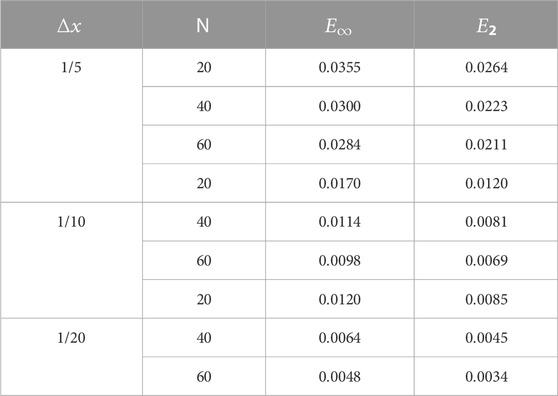
TABLE 1. Numerical results for example, 1 of the modified implicit scheme for various values of

TABLE 2. Numerical results example 1 of the modified implicit scheme for various values of
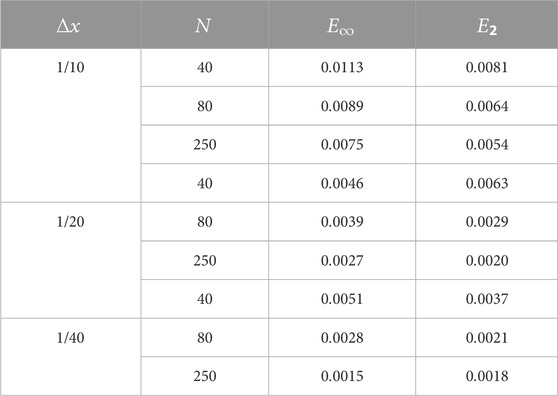
TABLE 3. Numerical results example 1 of the modified implicit scheme for various values of
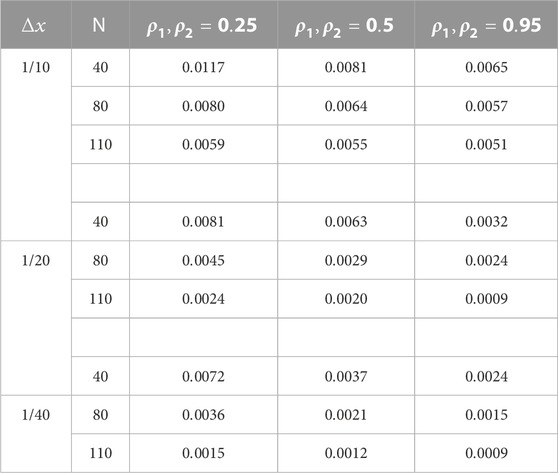
TABLE 4. Numerical results example 1 of the modified implicit scheme for various values of
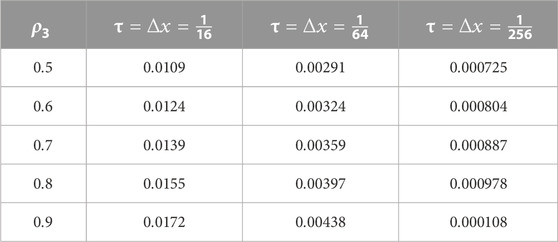
TABLE 5. Numerical results for example 2 of the modified implicit scheme for various values of
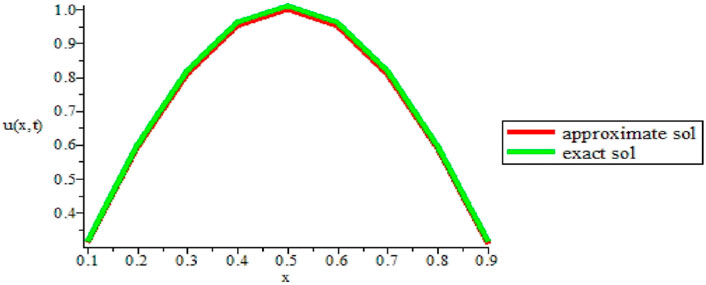
FIGURE 1. Comparison of the numerical and exact solution of the given example 1 at
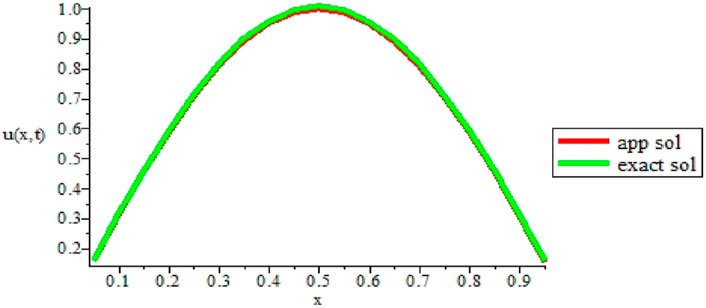
FIGURE 2. Comparison of the numerical and exact solution of the given example 1 at
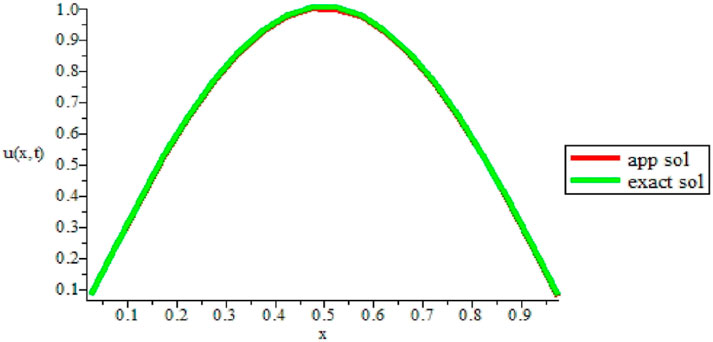
FIGURE 3. Comparison of the numerical and exact solution of the given example 1 at
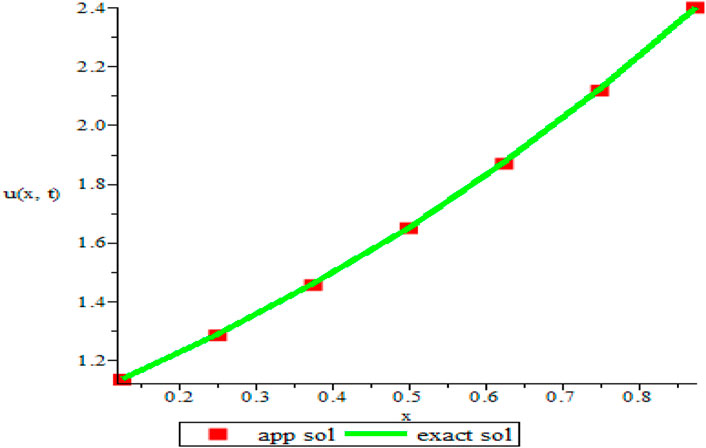
FIGURE 4. Comparison of the numerical and exact solution of the given example 1 at
7 Conclusion
This paper presented the modified implicit numerical approximation for a fractional one-dimensional linear Cable model. The scheme is convergent and unconditionally stable, as seen by the investigation using the Fourier series method. The time-fractional derivative was calculated using the Riemann–Liouville formula. The outcome of an application to specific examples of fractional order one-dimensional linear Cable model and the fractional order Stokes’ first problem for the heated generalized second-grade equation have been explored graphically and numerically. The scheme is verified through the comparison of the numerical solution with the exact solution, which shows an agreement with the theoretical analysis and the numerical experiment, confirming that the approximate solution converges to the exact solution. This modified approach can also extend to other types of two and three dimensional fractional order differential models.
Data availability statement
The raw data supporting the conclusion of this article will be made available by the authors, without undue reservation.
Author contributions
All authors listed have made a substantial, direct, and intellectual contribution to the work and approved it for publication.
Funding
The authors would like to thank the Deanship of Scientific Research at Umm Al-Qura University for supporting this work under Grant code: 22UQU4310396DSR58.
Conflict of interest
The authors declare that the research was conducted in the absence of any commercial or financial relationships that could be construed as a potential conflict of interest.
Publisher’s note
All claims expressed in this article are solely those of the authors and do not necessarily represent those of their affiliated organizations, or those of the publisher, the editors and the reviewers. Any product that may be evaluated in this article, or claim that may be made by its manufacturer, is not guaranteed or endorsed by the publisher.
References
1. Zhuang P, Liu F. Finite difference approximation for two-dimensional time fractional diffusion equation. J Algorithms Comput Technol (2007) 1:1–16. doi:10.1260/174830107780122667
2. Rajković PM, Marinković SD, Stanković MS. Fractional integrals, and derivatives in q-calculus. Appl Anal Discret Math (2007) 1:311–23. doi:10.2298/aadm0701311r
3. Yakar A, Akdogan Z. On the fundamental solutions of a discontinuous fractional boundary value problem. Adv Differ Equ (2017) 1:378–15. doi:10.1186/s13662-017-1433-6
5. Vitali S, Castellani G, Mainardi F. Time fractional cable equation, and applications in neurophysiology. Chaos Solitons Fractals (2017) 102:467–72. doi:10.1016/j.chaos.2017.04.043
6. Yu B, Jiang X. Numerical identification of the fractional derivatives in the two-dimensional fractional cable equation. J Sci Comput (2016) 68:252–72. doi:10.1007/s10915-015-0136-y
7. Liu F, Yang Q, Turner I. Two new implicit numerical methods for the fractional cable equation. J Comput Nonlinear Dyn (2011) 6(1-7):011009. doi:10.1115/1.4002269
8. Lin Y, Li X, Xu C. Finite difference/spectral approximations for the fractional cable equation. Math Comput (2011) 80:1369–96. doi:10.1090/s0025-5718-2010-02438-x
9. Liu Y, Du YW, Li H, Wang JF. A two-grid finite element approximation for a nonlinear time-fractional Cable equation. Nonlinear Dyn (2016) 85:2535–48. doi:10.1007/s11071-016-2843-9
10. Zhuang P, Liu F, Turner I, Anh V. Galerkin finite element method and error analysis for the fractional cable equation. Numer Algorithms (2016) 72:447–66. doi:10.1007/s11075-015-0055-x
11. Nikan O, Golbabai A, Machado JT, Nikazad T. Numerical approximation of the time fractional cable model arising in neuronal dynamics. Eng Comput (2020) 1–19.
12. Zhang H, Yang X, Han X. Discrete-time orthogonal spline collocation method with application to two-dimensional fractional cable equation. Comput Math Appl (2014) 68:1710–22. doi:10.1016/j.camwa.2014.10.019
13. Quintana-Murillo J, Yuste SB. An explicit numerical method for the fractional cable equation. Int J Differ Equ (2011) 2011:1–12. doi:10.1155/2011/231920
14. Baleanu D, Defterli O, Agrawal OP. A central difference numerical scheme for fractional optimal control problems. J Vib Control (2009) 15:583–97. doi:10.1177/1077546308088565
15. Langlands TAM, Henry BI, Wearne SL. Fractional cable equation models for anomalous electrodiffusion in nerve cells: Finite domain solutions. SIAM J Appl Math (2011) 71:1168–203. doi:10.1137/090775920
16. Langlands TAM, Henry BI, Wearne SL. Fractional cable equation models for anomalous electrodiffusion in nerve cells: Infinite domain solutions. J Math Biol (2009) 59:761–808. doi:10.1007/s00285-009-0251-1
17. Saxena RK, Tomovski Z, Sandev T. Analytical solution of generalized space-time fractional cable equation. Mathematics (2015) 3:153–70. doi:10.3390/math3020153
18. Bhrawy AH, Zaky MA. Numerical simulation for two-dimensional variable-order fractional nonlinear cable equation. Nonlinear Dyn (2015) 80:101–16. doi:10.1007/s11071-014-1854-7
19. Liu J, Li H, Liu Y. A new fully discrete finite difference/element approximation for fractional cable equation. J Appl Math Comput (2016) 52:345–61. doi:10.1007/s12190-015-0944-0
20. Ma L, Liu D. An implicit difference approximation for fractional cable equation in high-dimensional case. J Liaoning Tech Univ Nat Sci (2014) 4.
21. Zhang Y. A finite difference method for the fractional partial differential equation. Appl Math Comput (2009) 215:524–9.
22. Hu X, Zhang L. Implicit compact difference schemes for the fractional cable equation. Appl Math Model (2012) 36:4027–43. doi:10.1016/j.apm.2011.11.027
23. Moshtaghi N, Saadatmandi A. Numerical solution of time fractional cable equation via the sinc-Bernoulli collocation method. J Appl Comput Mech (2020) 7:1–9.
24. Aslefallah M, Abbasbandy S, Shivanian E. Fractional cable problem in the frame of meshless singular boundary method. Eng Anal Bound Elem (2019) 108:124–32. doi:10.1016/j.enganabound.2019.08.003
25. Ali U, Sohail M, Usman M, Abdullah FA, Khan Nisar KS. Fourth-order difference approximation for time-fractional modified sub-diffusion equation. Symmetry (2020) 12:691. doi:10.3390/sym12050691
26. Kumar S, ChauhanMomani RPS, Hadi S. Numerical investigations on COVID-19 model through singular and non-singular fractional operators. Numer Methods Partial Differential Equations (2020). doi:10.1002/num.22707
27. Kumar S, Kumar A, Samet B, Dutta H, A study on fractional host–parasitoid population dynamical model to describe insect species, Numer Methods Partial Differential Equations 37 (2), 1673–92. doi:10.1002/num.226032021). A study on fractional host–parasitoid population dynamical model to describe insect species,
28. Khan MA, Ullah S, S. K. A robust study on 2019-nCOV outbreaks through non-singular derivative. The Eur Phys J Plus (2021) 136:168.
29. Kumar S, Kumar R, Osman MS. A wavelet based numerical scheme for fractional orderSEIRepidemic of measles by using Genocchi polynomials. Numer Methods Partial Differential Equations (2021) 37(2):1250–68. doi:10.1002/num.22577
30. Mohammadi H, Kumar S, Rezapour S, Etemad S, A theoretical study of the Caputo–Fabrizio fractional modeling for hearing loss due to Mumps virus with optimal control, Chaos, Solitons and Fractals (2021) 144, 110668 doi:10.1016/j.chaos.2021.110668
31. Kumar S, Kumar R, Cattani C, Samet B, Chaotic behaviour of fractional predator-prey dynamical system, Chaos Solitons Fractals (2020)135, 109811 doi:10.1016/j.chaos.2020.109811
32. Ali U, Kamal R, Mohyud-Din ST. On nonlinear fractional differential equations. Int J Mod Math Sci (2012) 3(3):116–24.
33. Zubair T, Usman M, Ali U, Mohyud-Din ST. Homotopy analysis method for a system of partial differential equations. Int J Mod Eng Sci (2012) 1:67–79.
34. Ali U, Abdullah FA. Explicit Saul’yev finite difference approximation for the two-dimensional fractional sub-diffusion equation. In: AIP Conference Proceedings. AIP Publishing LLC (2018). 020111.
35. Ali U, Sohail M, Abdullah FA. An efficient numerical scheme for variable-order fractional sub-diffusion equation. Symmetry (2020) 12:1437. doi:10.3390/sym12091437
36. Yang Q. Novel analytical and numerical methods for solving fractional dynamical systems. Dr Diss Qld Univ Technol (2010) 1–201.
37. Povstenko Y, Ostoja-Starzewski M. Fractional telegraph equation under moving time-harmonic impact. Int J Heat Mass Transfer (2022) 182:121958. doi:10.1016/j.ijheatmasstransfer.2021.121958
38. Khater M, Ali U, Khan MA, Mousa AA, Attia RA. A new numerical approach for solving 1D fractional diffusion-wave equation. J Funct Spaces (2021) 2021:1–7. doi:10.1155/2021/6638597
39. Jumarie G. Modified Riemann-Liouville derivative and fractional Taylor series of non-differentiable functions further results. Comput Math Appl (2006) 51:1367–76. doi:10.1016/j.camwa.2006.02.001
Keywords: fractional cable equation, implicit approximation, stability, convergence, riemann-liouville fractional derivative
Citation: Ali U, Naeem M, Ganie AH, Fathima D, Salama FM and Abdullah FA (2023) Numerical approach for the fractional order cable model with theoretical analyses. Front. Phys. 11:1160767. doi: 10.3389/fphy.2023.1160767
Received: 07 February 2023; Accepted: 29 March 2023;
Published: 25 April 2023.
Edited by:
Alexander Nepomnyashchy, Technion Israel Institute of Technology, IsraelReviewed by:
Yuriy Povstenko, Jan Długosz University, PolandSunil Kumar, National Institute of Technology, India
Copyright © 2023 Ali, Naeem, Ganie, Fathima, Salama and Abdullah. This is an open-access article distributed under the terms of the Creative Commons Attribution License (CC BY). The use, distribution or reproduction in other forums is permitted, provided the original author(s) and the copyright owner(s) are credited and that the original publication in this journal is cited, in accordance with accepted academic practice. No use, distribution or reproduction is permitted which does not comply with these terms.
*Correspondence: Umair Ali, dW1haXJraGFubWF0aEBnbWFpbC5jb20=; Dowlath Fathima, ZC5mYXRoaW1hQHNldS5lZHUuc2E=
 Umair Ali
Umair Ali Muhammad Naeem
Muhammad Naeem Abdul Hamid Ganie
Abdul Hamid Ganie Dowlath Fathima
Dowlath Fathima Fouad Mohammad Salama
Fouad Mohammad Salama Farah Aini Abdullah
Farah Aini Abdullah